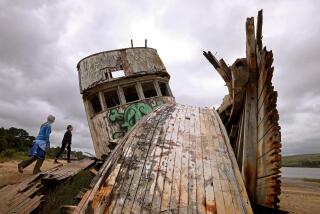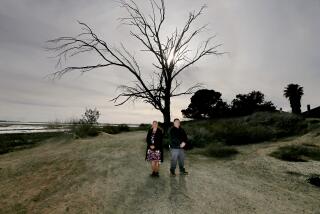Man Who Took Indian Artifact Gets Probation
A Pacific Palisades man who illegally picked up an old seashell during a walk on Santa Rosa Island was sentenced Monday in federal court to one year’s probation and ordered to pay $5,600 in fines.
Robert R. Bredin, 57, was also barred from visiting Channel Islands National Park during his probation.
Bredin, a pilot for United Airlines, pleaded guilty May 11 to removing an artifact--the shell he picked up and slipped into his backpack during a walk last year--from an ancient Native American archeological site.
The shell turned out to be a Chumash artifact about 6,000 years old, and removing it was a federal misdemeanor.
Bredin’s Los Angeles-area attorney, Harriet Leva, believes that the National Park Service reacted swiftly and strongly because officials thought Bredin was trying to start a business selling such artifacts.
As a pilot, Bredin had virtually unrestricted access to the islands, and he had volunteered for numerous National Park Service projects, Leva said.
“The fact that he was able to fly freely to the islands fit into the theory that this guy might be trading in Indian artifacts,” Leva said. “That’s what raised the suspicions. . . . That’s why I think they came down way too hard on this guy. They felt betrayed and they overreacted because they thought there was much more to it.”
But Thom Mrozek, spokesman for the U.S. attorney’s office, said Bredin was not a scapegoat. What he did was wrong, and he knew better, Mrozek said.
“We want to dispel the notion that this guy was singled out for any reason, or that he was subjected to any particularly vigorous prosecution,” Mrozek said. “It’s like if someone went to your grandfather’s grave and decided to take something out of it.
“In this case we were working to protect federal interests, and to vindicate the victims--which in this case were the Chumash people.”
Bredin flew a private plane to Santa Rosa Island for a picnic March 11 last year with his wife and brother-in-law. He has flown frequently to many of the Channel Islands and is a friend of a family that operates a cattle ranch on Santa Rosa.
Bredin and his two passengers stopped below a bluff for their picnic.
*
After lunch, Bredin and his brother-in-law poked around in the dunes. Several park rangers watched them through binoculars from a nearby pier and saw that they were in an area known to be an ancient Chumash grave site.
Bredin and his companions then hiked to another part of the island, where he found the abalone shell.
As Bredin and his companions were returning to the airstrip to fly back, they were stopped by park rangers, who asked if they had picked up anything.
Bredin opened his backpack and handed over the shell.
The rangers then searched his companions and Bredin’s airplane. They found nothing.
Within 48 hours, a team of archeologists was flown to the island to check the site where the picnickers had been.
They found that the bones of a Chumash mother and an 18-month-old child had been disturbed, said Assistant U.S. Atty. William W. Carter, who prosecuted the case.
Other bones--a long leg bone and a skull--were reportedly scattered in nearby grass.
The shell recovered from Bredin was sent to an expert at UC Santa Barbara for carbon-dating. It was found to be 6,300 years old.
On March 24, six federal agents and three Los Angeles police officers arrived at Bredin’s home with a federal search warrant.
Leva saw the shell at the sentencing Monday and said she was surprised by how small it was--no more than 4 inches across at its widest point. It looked dull on the outside and shiny on the inside, and did not appear old, she said.
Nor did it have a handle, or anything to indicate it had been used as a tool, she said.
“But the relevant question is, did it look old to him?” she said. “And the answer is, certainly not.”
Carter, however, said Santa Rosa Island is covered with many such artifacts. The place where Bredin found the shell is where the Chumash would bring up abalone shells and work on them, Carter said.
When agents searched Bredin’s house, they found a photograph of him taking the shell from the island location. They also found a videotape of a television program exploring the significance of abalone shells in Native American culture.
“Mr. Bredin obviously knew the significance of the shell, because he had someone take a picture of him taking the shell,” Carter said.
*
Mrozek of the U.S. attorney’s office added that Bredin was familiar with the island and was aware of the regulations protecting its archeological sites.
“Specifically, he knew that archeological sites are not to be tampered with,” Mrozek said.
Bredin was ordered to pay $2,500 in criminal fines and $3,100 in restitution to Channel Islands National Park.
Judge Lourdes Baird also ordered Bredin to write a letter of apology to the Chumash people.
Carter said his office decided not to press charges against Bredin’s brother-in-law, Thomas Butte, because he is terminally ill.
More to Read
Sign up for Essential California
The most important California stories and recommendations in your inbox every morning.
You may occasionally receive promotional content from the Los Angeles Times.










